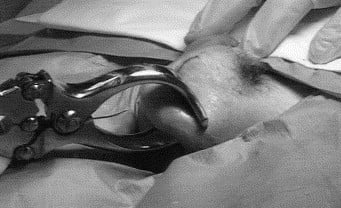When people think of castrating humans, they usually have images of livestock in their heads. This is because it’s a common practice to reduce aggression and sexual behavior in animals. However, there are other reasons that humans might want to consider the act of castrating humans too. In this guide, we’ll talk about the benefits and risks associated with human castration. Also, we will talk about how you can safely do the procedure yourself.
Contents
What are Castration/Castrating Humans?

When someone undergoes castration, it means they are made to be unable to have children. This is really mean. At birth, a baby boy’s testes are in the scrotum. They go there at birth, like all other boys. As a result, removing the descending testes (orchidectomy) and maybe the penis is a straightforward procedure. The act of castrating humans, in addition to causing infertility, significantly lowers the production of the male hormone testosterone.
Emasculating someone is when you make them weaker by taking away their power. A lot of times people will do this to a slave, a criminal, or a sex offender. In modern medicine, orchidectomy is one of the most typical methods to treat testicular cancer, and it usually involves removing only one testis. However, removal of both the testes aims to treat prostate cancer by reducing testosterone levels, or after a significant physical injury.
The term “castration” comes from a Medieval story about beavers, whose Latin name is castor. People targeted beavers for their sweet-smelling “castoreum”, which came from scent glands at the base of the penis. A beaver will do something when it is being chased. It can do many things, but it might do one thing. It could bite its own scrotum off and throw it at a pursuer. The testes in beavers stay in the belly and do not go down like they do in other animals. They are different than primates, who have them outside of their body.
Side Effects Of Castration
Castration after puberty, which turns males into eunuchs, reduces or eliminates the sex urge. Muscle mass, physical strength, and body hair frequently reduce in eunuchs, and they are often beardless. Breast enlargement is another prevalent condition. In the most well-known case of castration to avoid cuckoldry, there was a deployment of eunuchs as harem guards. Historically, eunuchs were more often used as servants, leaders of armies, and important people in government. They were viewed as less likely to cause trouble than other people.
The Sumerian city of Lagash has the first accounts of purposeful castration to make eunuchs, dating back approximately 4,000 years. In China, the eunuch system is a way that people were made to be like women. It was in society for a very long time and it lasted through many years. The last emperor threw from powers in 1911. Castration took place not just as a punishment, but also as a requirement for entry into imperial service. 70,000 eunuchs were engaged to serve the emperor at the end of the Ming Dynasty in the mid-17th century. Sun Yaoting, the last known eunuch of the Chinese imperial court, died in 1996, just before his 94th birthday.
In some different settings, men who are boys go through something called “castration”. Castration is when they cut off the man’s privates. This prevents their voice from changing as puberty does. Early castration prevents the drastic size increase in the larynx that would otherwise result in an adult man’s trademark “Adam’s apple”. Male voice chords develop by 63 percent after puberty, but female vocal cords grow by barely half as much.
Castrati skeletons
As one might expect, people know very little regarding the consequences of castration on the human skull and bones. However, in recent years, a number of research have begun to provide results. J.T. Eng and colleagues, for example, published the findings of an examination of two bones from eunuchs from China’s Ming Dynasty in 2010. (1368-1644 AD). One person had to go through castration before puberty because his lengthy limbs suggested that fusion at the ends of long bones. It normally happens in adulthood.
Following that, in 2011, the appropriately titled Maria Belcastro and her colleagues issued a study on the excavated bones of the Italian castrato singer Carlo Broschi (1705-1782), better known by his stage name Farinelli. Despite the fact that his skeleton was badly preserved, the study revealed traits that might connect to castration consequences, such as unusually lengthy limb bones, imperfect bone fusion, and low bone density (osteoporosis). The length of the single entirely intact limb bone — an ulna from the lower arm — generated a body height estimate of 6′ 3″. The inside of the skull cap had an impact by hyperostosis frontalis interna, a condition in which the innards of the skull cap damages severely.
Earlier this year, Alberto Zanatta and colleagues published identical discoveries for the completely entire bones of a second castrato singer, Gaspare Pacchierotti, including a comparable body height of roughly 6′ 3″ and evidence of osteoporosis (1740-1821). Some bones fused incompletely, as in Carlo Broschi’s skeleton. There was no evidence of hyperostosis frontalis interna at the front of the skull, however.
The Sistine Chapel’s Castrati
With Italy as its epicenter, passion for castrati musical performances persisted for nearly three centuries, beginning in the mid-16th century and lasting until the early 1900s. This was a common aspect in baroque and classical music, and notable composers like Handel (1685-1759) and Mozart (1756-1791) included castrati roles in multiple operas and oratorios. The Roman Catholic Church, on the other hand, was pivotal from the start. Indeed, the first evidence comes from Italian church documents from the 1550s, and by 1558, castrati were present in the choir of the Sistine Chapel.
In reality, they were necessary after the Vatican prohibited women from singing in church choirs in the mid-16th century. Pope Sixtus V reorganized the choir of St Peter’s Basilica in Rome in 1589, expressly mentioning castrati in his bull Cum pro nostri temporali more. In response to growing resistance, Pope Leo XIII barred the Roman Catholic Church from hiring new castrati in 1878, and Pope Pius X declared an end to the practice in 1903.
Castrating Humans And Lifespan
One possible benefit of the act of castrating humans (or perhaps just an undesired extension of all its disadvantages) is that removing the testes may increase an individual’s lifetime. There is a trade-off between testosterone levels and lifespan in animals, which might explain why women live longer lives than males. However, Eberhard Nieschlag and colleagues observed in 1993 that there was no difference in longevity between castrati and intact males. 50 intact male singers who had reached comparable renown and happen to match by year of birth compared to a control group of 50 intact male singers who had achieved comparable fame and matched by year of birth.
Nonetheless, Kyung-Jin Min and colleagues studied historical data regarding the longevity of 81 Korean eunuchs in a 2012 article. Scientists studied many men. They found that the average life of the group was 70 years. That is 17 years longer than three groups of men who look like them. In one study, Nieschlag and colleagues found that European castrated men had a higher sperm count than Korean eunuchs. In another study by Min and colleagues, the Korean eunuchs had a higher sperm count. Could the strains of professional singing outweigh any potential gain in longevity?
A Word From MantraCare
Your mental health — your psychological, emotional, and social well-being — has an impact on every aspect of your life. Positive mental health essentially allows you to effectively deal with life’s everyday challenges.
If you are looking for affordable Online Counseling MantraCare can help: Book a trial therapy session


